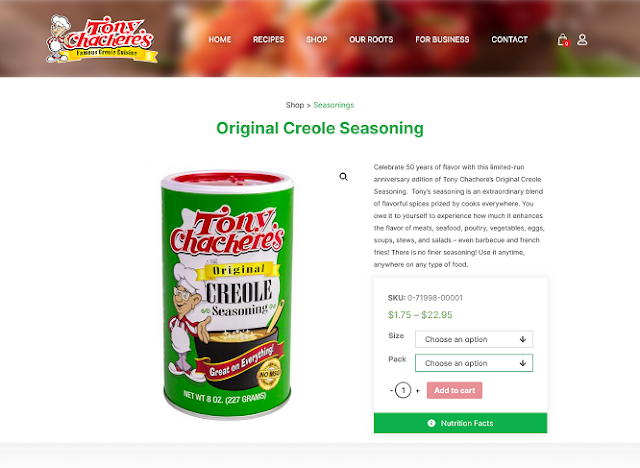If you have ever been to New Orleans, Louisiana US, then you know that region is known for its Cajun and Creole cooking. There is a difference between Cajun and Creole cooking. Some say Cajun dishes are spicier.
But I say no matter which ... it's all good!
Even though I have stood at a stove for 40+ years, my culinary skills are still at the newbie level. Dining out at "authentic" restaurants or even ordering for delivery is usually not an option. That's why I find shortcuts to creating the taste of a particular cuisine. I am happy to recommend two brands of seasonings for those who want to prepare their own Cajun or Creole dishes. The official websites for each of these companies have a section dedicated to recipes. But you might also find this cookbook helpful: The Easy Creole and Cajun Cookbook: Modern and Classic Dishes Made Simple by Ryan Boudreaux.
(NOTE: Read free with your Kindle subscription OR ... the paperback book is less than $10 so it would be a great idea for a white elephant gift exchange. 🎅)Best Seasoning for Cajun Cooking: Slap Ya Mama!
Yes, there is a difference between these two types of cuisines, but for
my palette, there is no difference. Every dish I have ever tried whether it was Cajun or Creole, it was
delicious.
But I have only been to New Orleans once and it is likely I will never visit again. If you are like me and you don't live in New Orleans but you want to try to make your own Cajun food, use slapyamama seasonings. You can shop for their products via the Amazon store OR go directly to their official website. You can also find recipes on the website. I met the company owner through Facebook years ago. They sent me free
samples of their products to try. Even though the Original Cajun Blend is the best seller, my favorite is the Cajun seasoning for fish fry. This company was founded in 2001 and is owned by The Walker family, (TW, Mama Jen, Jack, Joe, Tana, Andi, and Ruby).
***
Best Seasoning for Creole Cooking: Tony Cachere
Creole refers to people who are of mixed European and African descent (A
little French, a little Spanish, a little Afro-Caribbean, etc.). That
specific group of people made their home in Louisiana USA. (Just ask Beyoncé Knowles, the Creole Queen.) They have
their special style of cooking which is referred to as Creole cuisine.
If you have ever tasted Creole recipes and you want to make your own,
Tony Chachere is one of the best products on the market. They have been
in business since the 70s, about half a century. I discovered the Tony Chacere brand because one of my children bought a
can of the seasoning home from the local grocery store. He didn't want to use the herbs
and spices in my kitchen cabinet for his cooking, so he bought his own
flavorings.
Once I tried their Original Creole Seasoning, I was hooked! I use it to season meat, in my rice dishes, and on my veggies.
For those who may have to watch their salt intake, they have No-Salt seasonings. If you can not find their products at your local grocery store, go to Amazon OR to their official website. Tony Chachere is a real person. He is retired now but his business is still thriving.
Are you a newbie cook in the kitchen? Check out some of my other FW posts.























